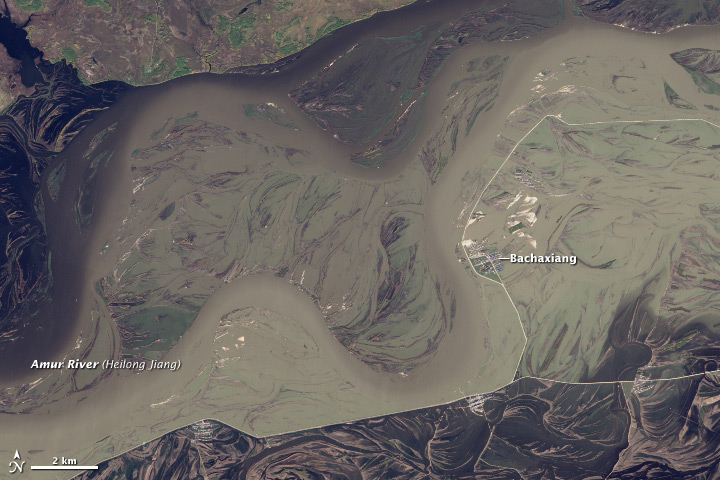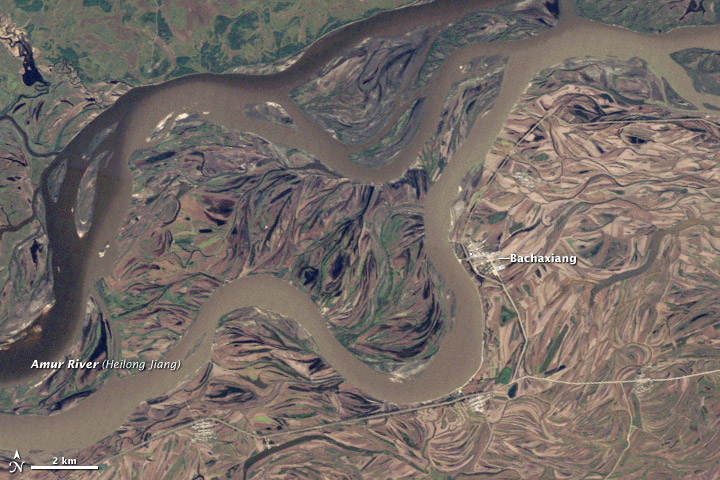NASA: China - Bachaxiang - Flooding along the Heilong River - 11.02.13
Posted by Ricardo Marcenaro | Posted in NASA: China - Bachaxiang - Flooding along the Heilong River - 11.02.13 | Posted on 11:35
The Amur River (Heilong Jiang in
Chinese) flows unfettered from Mongolia to China to Russia (forming the
Chinese-Russian border), and through Russia’s Far East into the Sea of
Okhotsk—a journey of 4,444 kilometers (2,761 miles). It is the tenth
longest river in the world, and the third longest without a dam.
Confined by mountains for most of its course, the river winds across a
vast alluvial flood plain in its midsection, where it grows and shrinks
dramatically throughout the year.
Water levels vary so much
that the river’s minimum recorded flow is just one percent of its
maximum recorded flow. Monsoon rains cause multiple floods each year,
usually in July and August, when the river can expand to 10 to 25
kilometers in width. Some years bring more extreme floods than others,
and 2013 proved to be the most extreme yet. Unusually heavy rains raised
parts of the river to their highest levels on record, forcing
evacuations and claiming lives in both China and Russia.
The Operational Land Imager on the Landsat 8
satellite acquired the top image on September 27, 2013. The river has
swallowed up the Chinese town of Bachaxiang, having overcome the
straight white levee that stands between the town and the river’s usual
channels.
The lower image, from the Landsat 5 satellite, shows the Amur/Heilong
River on September 19, 2010. The flood plain is covered by intertwined
channels cut during previous floods. Because of the nature of the flood
plain, water can linger for a long time. In this image, some of the old
channels still hold water, which appears nearly black in this scene.
Though occasionally destructive, the annual floods support the
biological diversity of the floodplain ecosystem. This region is part of
the Sanjiang Plain, where there are many significant and highly diverse
wetlands supporting 23 threatened species among many others. The floods
also deposit sediment on the plain, making the soil rich for
agriculture. The good soil and the climate make the Sanjiang a prime
grain-growing region, and several fields are visible beyond the river in
the large, downloadable images.
References
- Asian Development Bank (2013) Sanjiang Plain Wetlands Protection. Accessed October 24, 2013.
- RIA Novosti (2013, September 6) Amur River water level in flood-hit Khabarovsk on decline. Accessed October 24, 2013.
- Virtual information center for Amur River Region Amur-Heilong River Basin. Accessed October 24, 2013.
- World Water Database Amur River. Accessed October 24, 2013.
- Xinhua (2013, August 24) China allocates 580 mln yuan for flood victims. Accessed October 24, 2013.
NASA Earth Observatory image by Jesse Allen and Robert Simmon, using Landsat data from the U.S. Geological Survey. Caption by Holli Riebeek
- Instrument:
- Landsat 8 - OLI
NASA: China - Bachaxiang - Flooding along the Heilong River - 11.02.13
Ricardo M Marcenaro - Facebook
Blogs in operation of The Solitary Dog:
Solitary Dog Sculptor:
byricardomarcenaro.blogspot.com
Solitary Dog Sculptor I:
byricardomarcenaroi.blogspot.com/
Para:
comunicarse conmigo
comunicarse conmigo
marcenaroescultor@gmail.com
For:
contact me
For:
contact me
marcenaroescultor@gmail.com
My blogs are an open house to all cultures, religions and countries. Be a follower if you like it, with this action you are building a new culture of tolerance, open mind and heart for peace, love and human respect. Thanks :)
Mis blogs son una casa abierta a todas las culturas, religiones y países. Se un seguidor si quieres, con esta acción usted está construyendo una nueva cultura de la tolerancia, la mente y el corazón abiertos para la paz, el amor y el respeto humano. Gracias:)
(::)




Comments (0)
Publicar un comentario